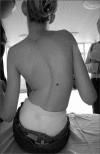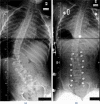Development and conservative treatment of spinal deformities in cerebral palsy
- PMID: 32165975
- PMCID: PMC7043120
- DOI: 10.1302/1863-2548.14.190127
Development and conservative treatment of spinal deformities in cerebral palsy
Abstract
Incidence and cause: Cerebral palsy (CP) is characterized by poor motor control. The more severe the affection is, the more patients are prone to deformities. Patients with Gross Motor Function Classification System level V run an up to 90% risk for spinal deformities. These are caused by poor trunk control under load. Although trunk tone is impossible to assess it seems to be low in the majority of patients, leading to collapse under gravity. The constant malposition results in growth asymmetry which leads to fixation and deterioration of the deformity.
Brace treatment: Brace treatment has a poor reputation in respect to the final outcome. Conventional braces as constructed for other spinal deformities are indeed difficult for patients with CP as they cannot change position in the brace and do not tolerate pressure on the belly for reflux problems. Respecting these points improves the tolerance of braces but still the time of use is far from the necessary when the trunk is upright. Nevertheless, they can help to postpone surgery for scoliosis, but they are very inefficient for sagittal plane deformities.
Aim of treatment: The lack of trunk control further leads to an impairment of head control and upper extremity function. Providing stability improves these problems. Braces are superior to seating shells for both treating deformity and providing stability as they remain close to the skin and follow movements. Supports on seating shells in contrast are too far away for controlling the deformity and provide stability only if the patient doesn't move forward.
Keywords: aim of treatment; cause; cerebral palsy; development of deformity; spinal braces corset; spinal deformity.
Copyright © 2020, The author(s).
Figures






References
-
- Yoshida S, Hayakawa K, Yamamoto A, et al. . Quantitative diffusion tensor tractography of the motor and sensory tract in children with cerebral palsy. Dev Med Child Neurol 2010;52:935-940. - PubMed
-
- Heyrman L, Desloovere K, Molenaers G, et al. . Clinical characteristics of impaired trunk control in children with spastic cerebral palsy. Res Dev Disabil 2013;34:327-334. - PubMed
-
- Persson-Bunke M, Hägglund G, Lauge-Pedersen H, Wagner P, Westbom L. Scoliosis in a total population of children with cerebral palsy. Spine (Phila Pa 1976) 2012;37:E708-E713. - PubMed
-
- Saito N, Ebara S, Ohotsuka K, Kumeta H, Takaoka K. Natural history of scoliosis in spastic cerebral palsy. Lancet 1998;351:1687-1692. - PubMed
Publication types
LinkOut - more resources
Full Text Sources
Research Materials
Miscellaneous

